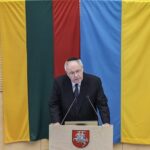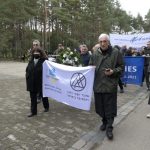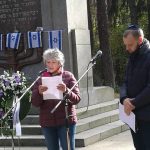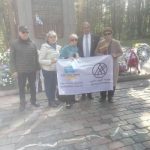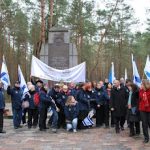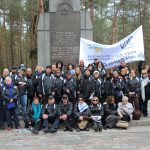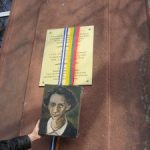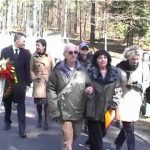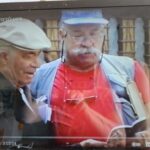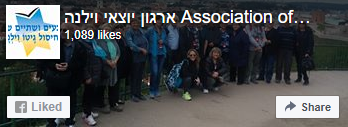Heritage tours in Lithuania
Dozens of survivors and their extended families go on multi-generational journeys to experience the lost Jewish heritage of Vilna, to learn about the horrors of the Holocaust and to become acquainted with the present-day Vilna Jewish community. The journeys are experiential and most exciting for three generations. We hear spine-tingling testimonies that have motivated dozens of survivors' extended families to join the Association's activities.
The March of the Living at Ponary
Since 2009, on Holocaust Memorial Day, heritage journeys to Vilna and the vicinity and Marches of the Living to Ponary have become an annual event. The participants are survivors and their extended families from Israel, Europe, North and South America, as well as government ministers: Yitzhak Herzog, Uzzi Landau, Danny Ayalon and Moshe (Bogi) Ya'alon. The chairman of Lithuanian Jewry, the Vilna community and its rabbis, the Israeli ambassadors to Lithuania and Latvia and the Lithuanian ambassador to Israel, the President of Lithuania, the chairman of the Lithuanian parliament and his deputies, ministers, the mayor of Vilna, the Prime Minister of Lithuania, the ambassadors of Russia, France, Great Britain, a representative from America, the teachers and pupils from the Jewish day school in Lithuania, Israeli students from the University of Kovno, representatives of the public and members of the community have all participated in the March of the Living to Ponary.
Memorial Services in Lithuania and Latvia
Every year members of the March of the Living delegation hold official memorial services as well as traditional ceremonies during their annual visit to Vilna, at the monument at Ponary and alongside one of the death pits; at the monument of the Ninth Fort in Kovno; at the central square and at the site of the Polygon in Švenčionys, at the memorial site in Nemenčine; at the monument to the Kaiserwald camp and at the Rumbula extermination site in Riga. Mayors, rabbis, leaders and members of the Jewish communities, representatives of the public and Israeli embassies participate in these ceremonies; the ceremonies include prayers, lighting memorial candles, reading appropriate texts and laying memorial wreaths.
The Prime Minister of Lithuania, accompanied by an entourage, visited Israel recently; during his visit he declared the March of the Living project a "tradition". The project was conceived because of the awareness of our need to perpetuate the memory of the Holocaust of the Jews of 'Jerusalem of Lithuania' in particular and the Holocaust of the Jews of Lithuania altogether, their culture and the memory of those who perished and to inculcate the future generations in Israel and the world with their values.
Survivors of the ghetto in Vilna and the vicinity and their extended families participate in the project. It combines tours of childhood haunts (living quarters, community and cultural centers) together with authentic testimonies by Holocaust survivors. The tours meander through the well preserved lanes of the ghetto and visit the historical and cultural sites of the illustrious community of Vilna. Most of the guided tours were conducted by the late Dr. Aharon Einat, a Holocaust survivor, whose doctorate focused on daily life in the H.K.P. labor camp and the ghetto.
The highlight of the tour is the March of the Living, a current symbolic response to the death marches from the train station at Ponary to the mass death pits. Groups from Israel and all over the world, pupils and teachers from the Shalom Aleichem, school in Vilna, Israeli students studying medicine at the University of Kovno, leaders and members of the Vilna and Lithuanian Jewish communities and heads of Jewish institutions in the Baltic States all participate in the March. An official memorial ceremony is held in the compound of the pits attended by the Israeli ambassador, the President of Lithuania, the Prime Minister of Lithuania, the chairman of the Lithuanian parliament, ministers, deputy ministers and other leading public figures. A traditional Jewish memorial ceremony, including lighting memorial candles, prayers and reading the names of those who perished, is held next to the death pit immediately after the formal one.
In 2012, a group of survivors who had been orphaned during the war joined the March of the Living. They were rounded up after the war and accommodated in an educational facility that was built especially for them. The Vilna Municipality, together with the Lithuanian Foreign Office, put up a plaque to commemorate the unique purpose of the building; those orphans still alive today were present for the official unveiling of the plaque together with the participants in the March of the Living and members of the Jewish community. The project was initiated by the Association in cooperation with the Lithuanian embassy in Israel, the Lithuanian Foreign Office and the Lithuanian government. This unique project, which makes it possible to document in real time the places where the survivors spent the war – in the Vilna Ghetto, the H.K.P. labor camp, the Ninth Fort at Kovno, the Rudniki forest where the partisans fought and the death pits -- meet the strictest criteria for inculcating and perpetuating the memory of the Holocaust.

